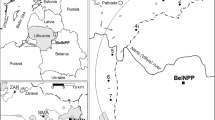Abstract
This paper presents an assessment of the modern radioecological situation in forest (pine, spruce, and birch forests) and fallow ecosystems in contaminated areas of Kaluga oblast, Russian Federation. The densities of soil contamination with natural radionuclides (226Ra, 232Th, and 40K) in the study area conform to the background levels; while the soil contamination with the technogenic radionuclide (137Cs) significantly exceeds the background level (3 kBq/m2) varying from 60.8 to 273.8 kBq/m2. Forest ecosystems (especially coniferous ones) are contaminated with 137Cs to the highest extent, while fallow ecosystems are least contaminated. The 137Cs contamination density in the soils has decreased by more than 3 times in comparison with the initial period after the fallout (1986); however, it still significantly exceeds the permissible level (37 kBq/m2). The total specific activity of soils and equivalent absorbed dose rates in ecosystems of contaminated areas are primarily determined by the 137Cs contribution; while, in background areas, it is determined by the 40K contribution.



Similar content being viewed by others
REFERENCES
Aleksakhin, R.M. and Naryshkin, M.A., Migratsiya radionuklidov v lesnykh biogeotsenozakh (Radionuclides Migration in Forest Biocenosises), Moscow, 1977.
Atlas radioaktivnogo zagryazneniya evropeiskoi chasti Rossii, Belorussii i Ukrainy (Radioactive Pollution of the European Part of Russia, Belorussia and Ukraine), Izrael’, Yu.A., Ed., Moscow, 1998.
Ashitko, A.G., Zolochevskii, D.V., Ovsyannikova, L.V., and Rozhkova, S.A., Radiation situation at Kaluga Region 30 years later the Chernobyl accident, Radiats. Gig., 2016, vol. 9, no. 2.
Badawi, W.M. and Mamikhin, S.V., On the attenuation of ν radiation by sod mid-podzolic soil, Moscow Univ. Soil Sci. Bull., 2010, vol. 65, no. 3, pp. 125–128.
Dubovaya, V.G., Analysis for factors which determine agriculture products pollution and grounding for protection measures for long-term period after the Chernobyl accident. By the example of polluted areas of Kaluga Region, Cand. Sci. (Biol.) Dissertation, Obninsk, 2001.
Klassifikatsiya pochv SSSR (Classification of the USSR Soils), Moscow, 1977.
Klyashtorin, A.L., Shcheglov, A.I., and Tsvetnova, O.B., Vertical migration of 137Cs in pine forest biogeocenoses, Eurasian Soil Sci., 1999, vol. 32, no. 12, pp. 1347–1352.
Lipatov, D.N., Shcheglov, A.I., and Tsvetnova, O.B., 137Cs content and distribution in forest and agroecological soils of Tula region, Radiats. Biol. Radioekol., 2007, vol. 47, no. 5.
Perevolotskii, A.N., Raspredelenie 137 Cs i 90 Sr v lesnykh biogeotsenozakh (137Cs and 90Sr Distribution in Forest Biogeocenosises), Gomel, 2006.
Tikhomirov, F.A., Shcheglov, A.I., Tsvetnova, O.B., et al., Radionuclides distribution and migration in radioactive polluted forests, in Radiatsionnye aspekty Chernobyl’skoi avarii (Radiation Aspect of Chernobyl Accident), St. Petersburg, 1993, vol. 2.
Fizicheskaya geografiya i priroda Kaluzhskoi oblasti (Kaluga Region: Physical Geography and Nature), Kaluga, 2003.
Tsvetnova, O.B., Bogatova, M.K., and Shcheglov, A.I., Soils properties effect onto 137Cs content and redistribution in nature and agroecological soils for long term period after the Chernobyl accident, in Radioecology of Forests and Forestry of Polissya of Ukraine, Kyiv, 2006.
Tsvetnova, O.B., Lipatov, D.N., and Shcheglov, A.I., Dynamics of Chernobyl 137Cs contamination fields at long distances, Moscow Univ. Soil Sci. Bull., 2007, vol. 62, no. 1, pp. 29–36.
Shcheglov, A.I., Tsvetnova, O.B., and Bogatyrev, L.G., Role of the different soil coatings in anthropogenic radionuclides migration, Vestn. Mosk. Univ., Ser. 17. Pochvoved., 2004, vol. 37, no. 4.
Almgren, S. and Isaksson, M., Vertical migration studies of 137Cs from nuclear weapons fallout and the Chernobyl accident, J. Environ. Radioact., 2006, vol. 91, nos. 1–2.
Kruyts, N., Titeux, H., and Delvaux, B., Mobility of radiocesium in three distinct forest floors, Sci. Total Environ., 2004, vol. 319, nos. 1–3, pp. 241–252.
Shcheglov, A.I., Tsvetnova, O.B., and Kliashtorin, A.L., Biogeochemical Migration of Technogenic Radionuclides in Forest Ecosystems, Moscow, 2001.
Staunton, S., Dumat, C., and Zsolnay, A., Possible role of organic matter in radiocaesium adsorption in soils, J. Environ. Radioact., 2002, vol. 58, nos. 2–3.
Author information
Authors and Affiliations
Corresponding authors
Ethics declarations
Conflict of interests. The authors declare that they have no conflicts of interest.Statement on the welfare of humans or animals. This article does not contain any studies involving animals performed by any of the authors.
Additional information
Translated by L. Emeliyanov
About this article
Cite this article
Tsvetnova, O.B., Kononets, O.P. & Shcheglov, A.I. Modern Radioecological Situation in Forest and Fallow Ecosystems of Kaluga Oblast. Moscow Univ. Soil Sci. Bull. 75, 176–183 (2020). https://doi.org/10.3103/S0147687420040067
Received:
Revised:
Accepted:
Published:
Issue Date:
DOI: https://doi.org/10.3103/S0147687420040067




